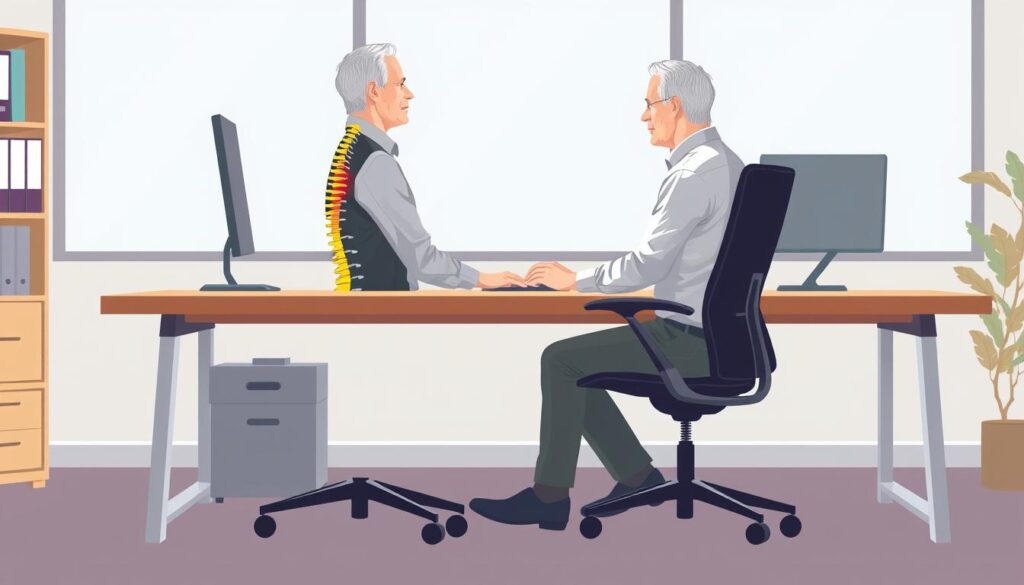Back pain is a big issue for men over 40. This guide has science-backed tips to help you manage and prevent back pain. It’s designed to keep you active and pain-free.
We know that everyone is different. So, we’ll show you a plan that includes movement, exercise, and more. It’s all about finding the right solution for your back pain, whether it’s from disc changes or spinal issues.
Understanding Age-Related Back Pain Causes
As we get older, our spines change, leading to back pain. The main causes are degenerative disk changes, spinal stenosis, and spondylolisthesis.
Degenerative Disk Changes
Disk degeneration is a big reason for back pain in older adults. The disks in our spine lose moisture and get less flexible with age. This makes them less effective at absorbing shock, leading to pain and nerve pressure.
Spinal Stenosis Explained
Spinal stenosis happens when the spinal canal gets narrower. This can be due to disk degeneration or thickened ligaments. It puts pressure on nerves, causing pain, numbness, and weakness in the back and legs.
Impact of Spondylolisthesis
Spondylolisthesis is when a vertebra slips forward or backward. This can irritate nerves and reduce mobility, making back pain worse. A mix of treatments is often needed to manage this condition.
Understanding the causes of back pain as we age is key to finding the right treatment. By addressing the spinal changes that come with aging, we can find ways to ease pain and stay active.
| Condition | Description | Prevalence |
|---|---|---|
| Degenerative Disk Changes | Loss of moisture and resilience in spinal disks, reducing their ability to act as shock absorbers. | Most commonly seen in individuals between 40 and 60 years of age. |
| Spinal Stenosis | Narrowing of the spinal canal, often due to disk degeneration or thickened ligaments, leading to nerve pressure. | Most commonly seen in individuals aged 60 and above. |
| Spondylolisthesis | Slippage of one vertebra forward or backward onto another, causing inflammation and reduced mobility. | Can occur in individuals of any age, but more prevalent in older adults. |
Essential Movement and Exercise Strategies
Staying active is key to managing back pain. Activities like walking, swimming, or cycling boost strength and endurance in your back. Core-strengthening exercises also help support your spine and ease pain.
Adding flexibility exercises can enhance your range of motion and lower back problem risks. Remember, “motion is lotion” for your spine. Being active makes you feel better.
If you’re not sure where to begin, a physical therapist can help. They’ll create a personalized exercise plan for you. This plan will focus on your specific needs and limitations.
They’ll guide you on how to safely and effectively add these strategies to your routine:
- Low-impact aerobic activities like walking, swimming, or cycling to build endurance
- Core-strengthening exercises to support your spine
- Flexibility exercises to improve range of motion
| Exercise | Starting Reps | Target Reps | Frequency |
|---|---|---|---|
| Lower Back Flexibility | 5 | 30 | Daily |
| Bridge | 5 | 30 | Daily |
| Cat Stretch | 3-5 | 3-5 | Twice Daily |
| Seated Lower Back Rotational Stretch | 3-5 | 3-5 | Twice Daily |
| Shoulder Blade Squeeze | 3-5 | 3-5 | Twice Daily |

Consistency is crucial in managing back pain. By regularly doing physical activity, core strength, and flexibility exercises, you can reduce pain and support your spine’s health.
Proven Back Pain Relief Methods
Dealing with back pain needs a mix of strategies. Start with cold therapy to cut down inflammation. Ice packs can help with sudden back pain. Then, switch to heat therapy to ease muscles and boost blood flow.
Rest is key, but don’t stay in bed for too long. Try to rest for no more than 48 hours to keep muscles strong.
For pain relief, NSAIDs like ibuprofen or naproxen are good. Use them in a pulsed way for 5-10 days. Sometimes, muscle relaxants are needed to stop muscle spasms. Always talk to your doctor before starting any new medicine.
Cold and Heat Therapy Applications
Cold therapy, like ice packs, can lessen inflammation and dull pain at first. After 2-3 days, move to heat therapy. It relaxes muscles and brings more blood to the area. This mix can manage pain management for back problems well.
Proper Rest and Recovery Techniques
- Limit bed rest to 48 hours maximum to prevent muscle weakening
- Engage in gentle stretching and low-impact exercises to maintain mobility
- Practice good sleep habits to allow your body to heal and recover
Medication Options and Management
Over-the-counter NSAIDs like ibuprofen or naproxen can lessen inflammation and ease back pain. Take them in a pulsed way for 5-10 days. Sometimes, muscle relaxants are given to calm muscle spasms.
| Medication | Typical Use | Potential Side Effects |
|---|---|---|
| NSAIDs (e.g., ibuprofen, naproxen) | Reduce inflammation and pain | Stomach upset, heartburn, ulcers |
| Muscle Relaxants | Relax muscle spasms | Drowsiness, dizziness, dependence |
Maintaining Proper Posture for Spinal Health
Ergonomics, sitting posture, and standing alignment are key for a healthy back. Good posture is not just about looks. It’s also vital for your spine’s health. By adopting the right postures, we can ease strain on our backs, necks, and shoulders.
When standing, keep your pelvis in a neutral position and avoid slouching. For long periods, use a low footstool and switch feet to ease back pain. Ergonomic adjustments at work, like standing desks, help with standing alignment.
Sitting for long can harm our posture, putting stress on our backs and shoulders. For good sitting posture, pick a chair with lumbar support and armrests. Keep your knees and hips even, and use a pillow for back support. Changing positions and standing breaks can also help.
- Maintain a 90-degree angle with your elbows while sitting to prevent strain on the spine.
- Ensure there is space to slide fingers under your thigh’s leading edge to decrease stress on the lower back.
- If there is more than a finger width between your thigh and the chair, raise the desk/work surface to adjust the chair height.
- Keep your eyes level with the center of the computer screen to avoid neck strain.
Proper lifting techniques are also key for good posture. When lifting, bend at the knees, keep your back straight, and hold the load close to your body.

By using these postural techniques daily, we can maintain proper ergonomics and support our spine’s health. Regular exercise, stretching, and good posture can prevent and manage back pain.
Alternative Therapeutic Approaches
At [Company Name], we see the value of other therapies for chronic back pain. Acupuncture can help the body heal and relieve pain. Osteopathic manipulation, done by DOs or chiropractors, uses hands-on methods to move and adjust the spine.
Physical therapy offers exercises and manual therapies to boost strength and flexibility. It also helps improve posture.
Acupuncture Benefits
A 2013 study in the journal Spine found that acupuncture might help with back pain. Thin needles are placed in certain body points to release endorphins, the body’s natural painkillers. This ancient Chinese method can lessen back pain and aid in healing.
Osteopathic Manipulation
Osteopathic manipulation is a valuable tool for back pain management. 12 sessions with a licensed chiropractor, osteopathic physician, or physical therapist can offer quick relief and long-term benefits. These techniques align the spine, enhance blood flow, and ease muscle tension, all helping to reduce back pain.
Physical Therapy Options
Physical therapy takes a comprehensive approach to back pain relief. It includes tailored exercises and manual therapies to strengthen the core and improve spinal health. Yoga and Pilates practiced 3 to 4 times a week can also reduce back pain. These practices enhance flexibility, posture, and muscle balance.
By using these alternative therapies, either alone or with traditional treatments, people can manage their back pain better. This holistic approach can improve their overall quality of life.
Lifestyle Modifications for Prevention
Keeping a healthy lifestyle is crucial for managing and preventing back pain. By focusing on weight management, smoking cessation, and stress reduction, we can lower the risk and severity of back problems.
Carrying extra weight puts extra stress on your back muscles and joints, leading to pain. A balanced diet and regular exercise can help you maintain a healthy weight. If you smoke, quitting can greatly reduce your risk of back issues.
Managing stress is also key. Practices like meditation, deep breathing, and yoga can relax your muscles and reduce tension that causes back pain. Getting enough, quality sleep on a supportive mattress is also important for your back’s health.
While there’s no single solution, making these lifestyle changes can be very helpful. By taking a proactive, holistic approach, you can enjoy better comfort and mobility for years to come.
| Lifestyle Factor | Impact on Back Health |
|---|---|
| Weight Management | Excess weight increases stress on the back, leading to pain and injury. |
| Smoking Cessation | Smoking is linked to a higher risk of back problems and slower healing. |
| Stress Reduction | High stress can cause muscle tension and spasms, exacerbating back pain. |
Advanced Treatment Options and When to Seek Help
If your back pain doesn’t get better or gets worse, it’s time to look into more advanced treatments. Our team of spine specialists can help. They will give you personalized advice based on your condition.
Professional Medical Interventions
For long-lasting or severe back pain, spinal injections might be the answer. These include nerve blocks or steroid injections. Sometimes, procedures like spinal cord stimulation or vertebroplasty are better. These treatments use modern methods to target pain relief without big surgery.
Warning Signs to Watch For
Be on the lookout for warning signs that mean you need to see a doctor right away. Look out for pain that goes down your legs, numbness or weakness in your legs, and changes in bowel or bladder function. These could mean nerve damage or other serious issues. Getting help early can make a big difference, so don’t wait to see a spine specialist if you’re worried.










